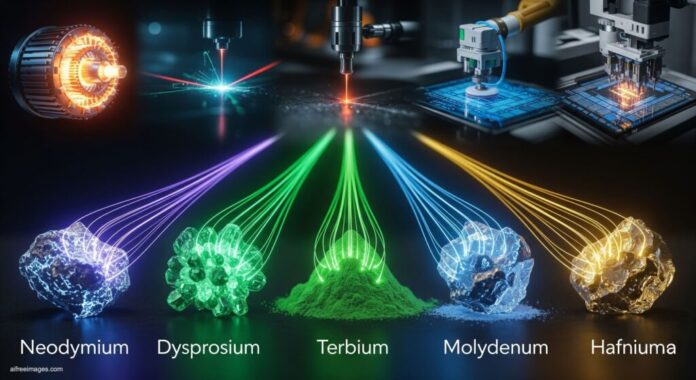In the current global competition for technological leadership in the 21st century, attention is focused on semiconductors, renewable energies, and electric mobility. However, less visible elements, but equally critical, are the materials that intervene in these advances. Elements such as neodymium, dysprosium, terbium, molybdenum, and hafnium, all of which are essential, are at the center of a dispute that is not only technological, but also geopolitical.
Neodymium, a key component in the manufacture of high-power permanent magnets, drives electric vehicle motors and wind turbine generators. China, which controls more than 80% of its production, stands as a decisive global actor, impacting key Western industries.
Dysprosium, in turn, enhances the thermal resistance of these magnets, which is crucial for the operation of high-performance vehicles and nuclear reactors. Its scarcity intensifies efforts to recycle and reduce dependence on primary sources.
Terbium, although less well known, is essential in the manufacture of high-power lasers and LED displays. The limited production, also concentrated in China, positions this element as one of the most expensive on the international market.
For molybdenum, the geographic diversification of its production, with countries such as Chile and Peru at the forefront, partially mitigates the vulnerability of its supply. Used in the electronics and energy industries, this metal offers high resistance to corrosion and thermal stability, being vital for aerospace components and catalysts in refineries.
Meanwhile, hafnium plays a silent but fundamental role in the miniaturization of advanced semiconductors. Its applications in transistors and nuclear reactors underline its strategic importance, with its limited production posing a challenge to be addressed.
The geopolitics of these materials presents a scenario of technological fragility. The concentration of its production in the hands of a few countries leaves global economies exposed to potential trade or geopolitical conflicts. Countries such as the United States, Europe, India and Japan are seeking strategies to diversify and secure the supply through recycling, exploration of new deposits and development of new technologies.
Initiatives such as magnet recycling, mining exploration in new regions, and investment in China's independent refining are steps toward greater stability. International alliances, such as the one between India and Australia, reinforce the pursuit of independence in accessing these materials.
The fight for these critical components not only defines industrial and technological leadership, but also constitutes a new invisible battle in the digital era. As innovation advances with visible developments, the control of these underlying resources represents an enormous competitive advantage in the global economy, remembering that at the heart of today's technological revolution, critical materials are the essential foundations.
More information and references in Cloud News.



